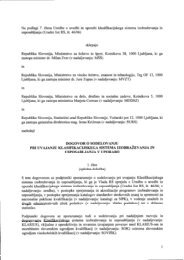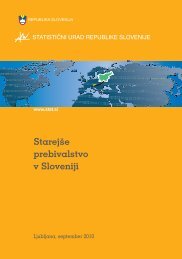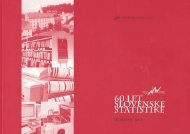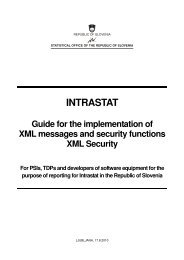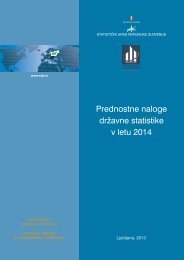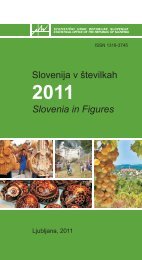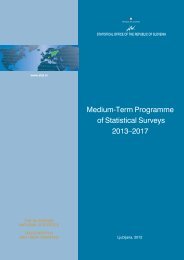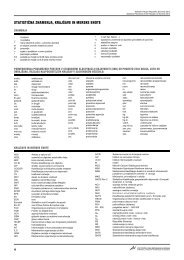slovenija A5.pmd - StatistiÄni urad Republike Slovenije
slovenija A5.pmd - StatistiÄni urad Republike Slovenije
slovenija A5.pmd - StatistiÄni urad Republike Slovenije
Create successful ePaper yourself
Turn your PDF publications into a flip-book with our unique Google optimized e-Paper software.
Statistièni portret <strong>Slovenije</strong> v Evropski uniji<br />
Statistical Portrait of Slovenia in the EU<br />
Uvodna beseda<br />
Evropska unija je od 1. maja 2004 skupnost 25 držav - nova identiteta, za katero<br />
smo se državljani èlanic odloèili zaradi skupnih interesov in enakih demokratiènih<br />
vrednot. Vkljuèitev <strong>Slovenije</strong> v EU je bila naš prednostni cilj, ki smo ga 23. marca<br />
2003 podprli tudi na referendumu.<br />
Identiteta EU se bo v prihodnje vzajemno spreminjala z razvijanjem posameznih<br />
držav èlanic, vendar bo vsaka še naprej ohranjala tudi lastno identiteto. Pestrost<br />
razliènih kultur, jezikov, religij in zgodovinskih izkušenj držav èlanic EU pa že sama<br />
ustvarja ozraèje in obmoèje svobode, praviènosti, spoštovanja èlovekovih pravic -<br />
vrednot demokracije. Hkrati pa združena Evropa omogoèa zlasti manjšim samostojnim<br />
državam, da se uveljavijo - strokovno, socialno in gospodarsko.<br />
Kot okvir za vzpostavitev odnosov med nami, evropskimi državljani, in s politiènimi<br />
institucijami Evropske unije smo se države èlanice odloèile sprejeti ustavno pogodbo<br />
EU in nekatere so jo že zaèele ratificirati. "Vsi državljani držav èlanic so tudi<br />
državljani EU". Nacionalno državljanstvo se s tem le nadgrajuje, posebno glede<br />
èlovekovih pravic in svobošèin.<br />
V tej publikaciji Vam Evropsko unijo in položaj <strong>Slovenije</strong> med njimi prikazujemo s<br />
statistiènimi podatki. Metodologije zbiranja in izkazovanja statistiènih podatkov<br />
smo nacionalni statistièni <strong>urad</strong>i skupaj z Eurostatom, Statistiènim <strong>urad</strong>om<br />
Evropskih skupnosti, v preteklem desetletju usklajevali prav zato, da lahko danes<br />
s primerljivimi podatki portretiramo Evropsko unijo. Predstavljamo Vam le nekaj<br />
zanimivejših, osnovnih podatkov o posameznih državah èlanicah. Nekateri kazalniki<br />
vsaj nakazujejo tudi naèin življenja in bivanja prebivalcev v njih, podrobnejše<br />
predstavitve pa so na voljo tudi na spletnih straneh Statistiènega <strong>urad</strong>a <strong>Republike</strong><br />
<strong>Slovenije</strong> www.stat.si.<br />
Želimo, da bi Vam ta publikacija našo širšo skupnost in njene prebivalce vsaj nekoliko<br />
približala.<br />
Introductory words<br />
On 1 May 2004 the European Union became a community of 25 countries with a<br />
new identity for which the citizens in Member States decided because of common<br />
interests and equal democratic values. The accession of Slovenia to the EU was our<br />
priority objective, which we realized at a referendum held on 23 March 2003.<br />
The EU identity will change with the development of its Member States; however,<br />
each EU Member State will continue to preserve its own identity as well. The variety<br />
of different cultures, languages, religions and historical experiences of EU Member<br />
States will create the atmosphere and area of freedom, justice, respect of human rights,<br />
i.e. democratic values. At the same time the united Europe provides smaller, independent<br />
states with the possibility to assert themselves professionally, socially and economically.<br />
In order to establish relations among EU citizens on the one hand and those with<br />
political institutions of the European Union on the other hand, EU Member States<br />
have decided to adopt the Constitutional Treaty for the EU and some of them have<br />
already ratified it. The Treaty states that "every citizen of a Member State is a<br />
citizen of the EU", which means that national citizenship is thus upgraded, especially<br />
as regards human rights and freedoms.<br />
In this publication the European Union and Slovenia's position in it are presented<br />
with statistical data. In the past decade National Statistical Institutes and Eurostat,<br />
the Statistical Office of the European Communities, have been harmonising the<br />
methodology of collecting and disseminating statistical data in order to be able to<br />
present the European Union with comparable data. This publication brings only some<br />
of the most interesting, basic data on individual Member States. Nevertheless, some<br />
of the indicators at least attempt to indicate how people live in these countries. More<br />
detailed information is available on the web site of the Statistical Office of the Republic<br />
of Slovenia www.stat.si.<br />
We wish that this publication would help you get an insight into the new wider<br />
community and its population.<br />
Mag. Irena Križman<br />
generalna direktorica<br />
Director-General



